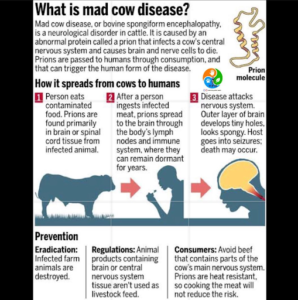In news– Brazil halted beef export to China after a case of mad cow disease was confirmed in the northern state of Para.
What is Mad Cow Disease?
- Mad Cow Disease, also known as Bovine Spongiform Encephalopathy (BSE), is a deadly and slowly progressive infection affecting adult cattle’s central nervous system. It is degenerative and can be transmitted to humans who consume contaminated meat products.
- It can be contracted by a cow if it eats feed that has been contaminated with parts of another cow that was infected with BSE.
- BSE is a result of an abnormal protein called a prion, which typically exists on the surface of cells.
- This prion transforms into a harmful form that harms the nervous system, including the brain and spinal cord.
- The presence of this altered protein is undetected by the affected cow’s body, making it impossible for the cow to fight off the disease.
- The disease leads to neurological symptoms. One of the most common symptoms of BSE in cows is incoordination, which means the cow has difficulty walking and standing up.
- The cow may also show signs of nervousness or aggression. These symptoms typically appear when the cow is in the final stages of the disease.
- The incubation period of BSE, which is the time from when a cow is infected with the prion to when it shows symptoms, can range from four to six years. During this period, there are no visible signs of the disease.
- Once a cow starts showing symptoms of BSE, it progressively gets worse until it dies. The duration of the disease can range from two weeks to six months.
- There is no cure for BSE, and infected cows are typically euthanized to prevent the spread of the disease to other cows and humans.
- It has no known treatment and there is no vaccine available to prevent it.

Source: Times of India
















